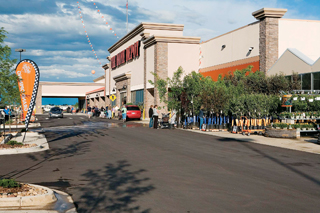

Best places: D to J
Nora Caley //May 1, 2012//

Metro Denver
The redevelopment of historic Union Station, a project that will combine a multi-modal transportation hub along with retail, office and residential space in Lower Downtown, is the most significant project to take place in the city’s center in years (see the Quarterly Real Estate Report on page 28 of this issue).
Another development: SCL Health System, which operates Saint Joseph Hospital in Denver; Lutheran Medical Center in Wheat Ridge, Good Samaritan Medical Center in Lafayette, and other health-care facilities, announced it will move its headquarters from Kansas to Colorado over the next four years. Metro Denver EDC says the move will bring 750 positions to Denver and Broomfield. For incentives, the City and County of Denver provided $350,000 from its job development fund, the City and County of Broomfield provided $500,000, and the state of Colorado provided $937,000.
Separately, the Minneapolis-based retailer Target will reportedly receive $5 million in tax increment financing from Denver if it opens a store in the former Tamarac Square Mall.
More information: www.metrodenver.org.
Douglas County
Between 2000 and 2010, Douglas County’s population increased a whopping 62 percent, to 285,000 residents. The county offers fee waivers, a business tax rebate and an infrastructure incentive program. The county also offers a streamlined permitting process and expedited development review. The ability to meet an aggressive permitting schedule attracted Polystrand’s expansion into Douglas County, says Meme Dunckel Martin, economic development manager. The manufacturer of fiber-reinforced thermoplastic composites, a subsidiary of Gordon Composites, was based in Montrose.
The company wanted to expand, and also wanted better access to transcontinental highways, major rail lines, and proximity to Denver International Airport and Centennial Airport. It also wanted to move quickly, and Douglas County was able to oblige. Polystrand met with county representatives in January 2011, and broke ground on its 120,000-square-foot, $14 million office and manufacturing plant in June 2011.
“We create a business-friendly environment by cutting red tape and removing regulatory roadblocks,” Martin says. “Polystrand has plans to double its Douglas County facility in the near future.” Polystrand still has a facility in Montrose.
More information: www.BusinessDouglasCounty.com.
Durango/La Plata County
Durango, a mecca for outdoor enthusiasts, is the largest city in Southwest Colorado. It has been dubbed the “mountain biking capital of the world” and has the most micro or craft breweries per capita in the state – its four breweries amount to one brewery for every 3,480 residents.
The City of Durango and the La Plata County Economic Development Alliance partnered to establish a small block grant to help with infrastructure costs or work-force training for primary businesses.
The Alliance is developing a business retention program that will meet with 50 to 75 businesses each year. New businesses include Aventouras, an outdoor adventure travel company that relocated in June 2011.The only drawback to the area is lack of available space, says Roger Zalneraitis, executive director of the Alliance.
“We are in the process of developing two new business parks, so that should be alleviated in the next two to three years,” he says.
More information: www.yeslpc.com.

Firestone
Firestone has low tax rates, says Mayor Chad Auer, and also an approval process that is transparent and easy. The city’s best assets, he says, is location, a business-friendly environment, and political stability. Firestone also attends trade shows such as Solar Power International and retail shows. Home Depot opened a store in Firestone in June 2009, a big win during the economic downturn.
“Home Depot didn’t build but a handful of stores in that time, and Firestone was one of the few they built,” Auer says. “We worked proactively with the developer and business leaders. We leveraged our demographics, location and ‘can do’ attitude to sell them on Firestone as the location for their next store. It was a win-win for everyone.”
More information: www.ci.firestone.co.us.
Englewood
The Englewood City Council recently approved a tax incentive to support the redevelopment of a grocery-anchored shopping center. The incentive rebates one-time use tax and sales tax up to four years to offset the cost of certain infrastructure improvements. There are also tax credits associated with the Arapahoe County Enterprise Zone. Englewood recently partnered with the South Metro Denver Chamber of Commerce to serve on its Business Retention and Expansion Ambassador’s program, an initiative that involves meeting with 1,000 employers in the south metropolitan market over the next 12 months.
Englewood has moved well past the demise of its former anchor Cinderella City, the largest covered shopping center west of the Mississippi when it was completed in 1968. The retail behemoth went into decline in the 1980s and closed in 1997. “Because the decline was gradual, our revenues during that time period were more flat than in decline,” says Michael Flaherty, deputy city manager for the City of Englewood. “Also, the addition of the Home Base and Home Depot stores during that time period helped to stem the tide.”
He says after the closure of Cinderella City, the city negotiated an agreement with the owners to assume the site, along with its environmental issues, for redevelopment. “With the pending arrival of the Southwest Light Rail line, the city council chose to develop the mixed-use/transit oriented CityCenter Englewood development that stands today. It has been nearly 12 years since the opening of the Southwest Light Rail line, and the city is now in the process of planning for future development along the light rail corridor throughout Englewood, including some possible future changes to CityCenter. Change is the constant,” he says.
More information: www.englewoodgov.org.
Grand Junction
The Grand Junction Economic Partnership focuses on five target industries: medical/health care, aerospace, IT/professional services, outdoor industry and energy. Executive director Kelly Flenniken says GJEP manages a small cash-incentive pool and can offer free and discounted land for primary business development.
For retention, GJEP partnered with other local business-resource organizations and created a local “First Responder Team” that provides educational seminars and business and community resources. In 2007 GJEP worked with cable transport system manufacturer Leitner-Poma of America on its expansion into a new facility.
More information: www.gjep.org.
Greenwood Village
Greenwood Village strives to offer businesses a high level of service, says Mayor Ron Rakowsky. Businesses are attracted to Greenwood Village’s permitting/development processes, police services, parks and streetscapes, and its location near I-25 and light rail. Merrick and Co., an engineering firm with $125 million in annual revenues, announced it was moving its headquarters to the Village.
“We committed to partner with them to get them through their tenant improvement processes in a quick and professional manner,” Rakowsky says. “That, along with some outreach to partner organizations that offer transit solutions to businesses and a very modest temporary tax incentive, sealed the deal for them.”
More information: www.greenwoodvillage.com.
Jefferson County
Jefferson County focuses on three selling points: quality workforce, diversified industry base and long-term relationships. Some relationships are very long term. Outdoor products manufacturer Coleman Co. moved its headquarters to unincorporated Jefferson County, to a log cabin-style building, in 1995. Two years later the company moved to Wichita, Kan.
Michelle Claymore, vice president of the Jefferson County Economic Development Corp., says she recently fielded a call from a real estate broker who wanted to find a building for a company seeking to move its headquarters to Colorado. “The company was looking at Denver because they wanted to bring in executive talent from the area, and creative talent, graphic artists and social media experts,” she says.
The company turned out to be Coleman, and Claymore, who has worked for the Jefferson County EDC since 1995, steered Coleman back to the log cabin. “Everyone still called it ‘the Coleman building,’” she says. “That became my marketing ploy.” The building wasn’t for sale, so the EDC worked with Coleman and with real estate people to negotiate a sale. The EDC also offered an incentive package, and even convinced a nearby Marriott hotel to hold a hiring event. Coleman employees will move into the 36,500-square-foot office building in June.
More information: www.jeffcoedc.org.

























